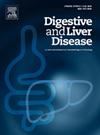High burden of MASLD and metALD in People with HIV: a call for liver fibrosis screening prioritization
IF 4
3区 医学
Q1 GASTROENTEROLOGY & HEPATOLOGY
引用次数: 0
Abstract
Background
Evidence suggests that metabolic dysfunction-associated steatotic liver disease (MASLD) has heightened severity in people with HIV (PWH). However, hepatology guidelines do not recognize HIV as a risk factor for MASLD and fibrosis. Most data rely on the outdated NAFLD nomenclature, emphasizing the need for research within the MASLD framework.
Aim
to assess the prevalence and factors associated with steatotic liver disease (SLD), its subcategories, and significant liver fibrosis in PWH.
Methods
We analyzed data from clinical centers in Canada, Italy and Germany on consecutive PWH undergoing unselected screening for SLD and liver fibrosis. SLD was defined as controlled attenuation parameter >248 dB/m. MASLD was defined as SLD plus ≥1 cardiometabolic factor without alcohol intake >20-30g/day. Metabolic dysfunction- and alcohol-associated liver disease (MetALD) was defined as SLD with ≥1 cardiometabolic factor and alcohol intake 20-60g/day. Alcohol-associated liver disease (ALD) was defined as SLD with alcohol intake >60g/day. Cryptogenic SLD (cSLD) was defined as SLD without cardiometabolic risk factors or other causes of SLD. Significant liver fibrosis and cirrhosis were diagnosed by liver stiffness measurement >8 kPa and >13 kPa, respectively. Logistic regression was used to investigate factors associated with MASLD and fibrosis.
Results
Among 3,006 PWH (median age 53, 25% female, all on ART, 85% with undetectable HIV viral load), 14% had HCV coinfection and 3% had HBV coinfection. SLD, MASLD, MetALD, cSLD, and ALD prevalence were 43.4%, 26.2%, 9.8%, 5.2%, and 2.2%, respectively. Overall, 11.2% had significant fibrosis, and 3.5% had cirrhosis. PWH with MASLD and MetALD had a significantly higher prevalence of significant fibrosis and cirrhosis compared to those without SLD (Figure). In multivariable analysis, body mass index (OR 1.28, 95% CI: 1.21–1.32) and age >50 (OR 1.47, 95% CI: 1.07–2.08) were independently associated with MASLD after adjusting for sex, duration of HIV infection, ALT, GGT, nadir CD4 <200 cells/uL, and use of integrase inhibitors. Significant fibrosis was associated with age (OR 1.01, 95% CI: 1.00–1.06), male sex (OR 1.53, 95% CI: 1.13–2.25), MASLD (OR 2.55, 95% CI: 1.70–3.25), MetALD (OR 1.89, 95% CI: 1.17–2.99), integrase inhibitor use (OR 1.65, 95% CI: 1.17–2.24), nadir CD4 <200 cells/uL (OR 1.45, 95% CI: 1.06–1.98), and HCV coinfection (OR 3.41, 95% CI: 2.46–4.71), while HBV coinfection was not.
Conclusion
The updated SLD definition reveals a high prevalence of significant liver fibrosis in PWH, driven by hepatic steatosis with metabolic alterations (MASLD and MetALD), HIV-related factors, and HCV coinfection. PWH should be globally recognized as a high-risk population for MASLD and prioritized for liver fibrosis screening.
求助全文
约1分钟内获得全文
求助全文
来源期刊

Digestive and Liver Disease
医学-胃肠肝病学
CiteScore
6.10
自引率
2.20%
发文量
632
审稿时长
19 days
期刊介绍:
Digestive and Liver Disease is an international journal of Gastroenterology and Hepatology. It is the official journal of Italian Association for the Study of the Liver (AISF); Italian Association for the Study of the Pancreas (AISP); Italian Association for Digestive Endoscopy (SIED); Italian Association for Hospital Gastroenterologists and Digestive Endoscopists (AIGO); Italian Society of Gastroenterology (SIGE); Italian Society of Pediatric Gastroenterology and Hepatology (SIGENP) and Italian Group for the Study of Inflammatory Bowel Disease (IG-IBD).
Digestive and Liver Disease publishes papers on basic and clinical research in the field of gastroenterology and hepatology.
Contributions consist of:
Original Papers
Correspondence to the Editor
Editorials, Reviews and Special Articles
Progress Reports
Image of the Month
Congress Proceedings
Symposia and Mini-symposia.
 求助内容:
求助内容: 应助结果提醒方式:
应助结果提醒方式:


